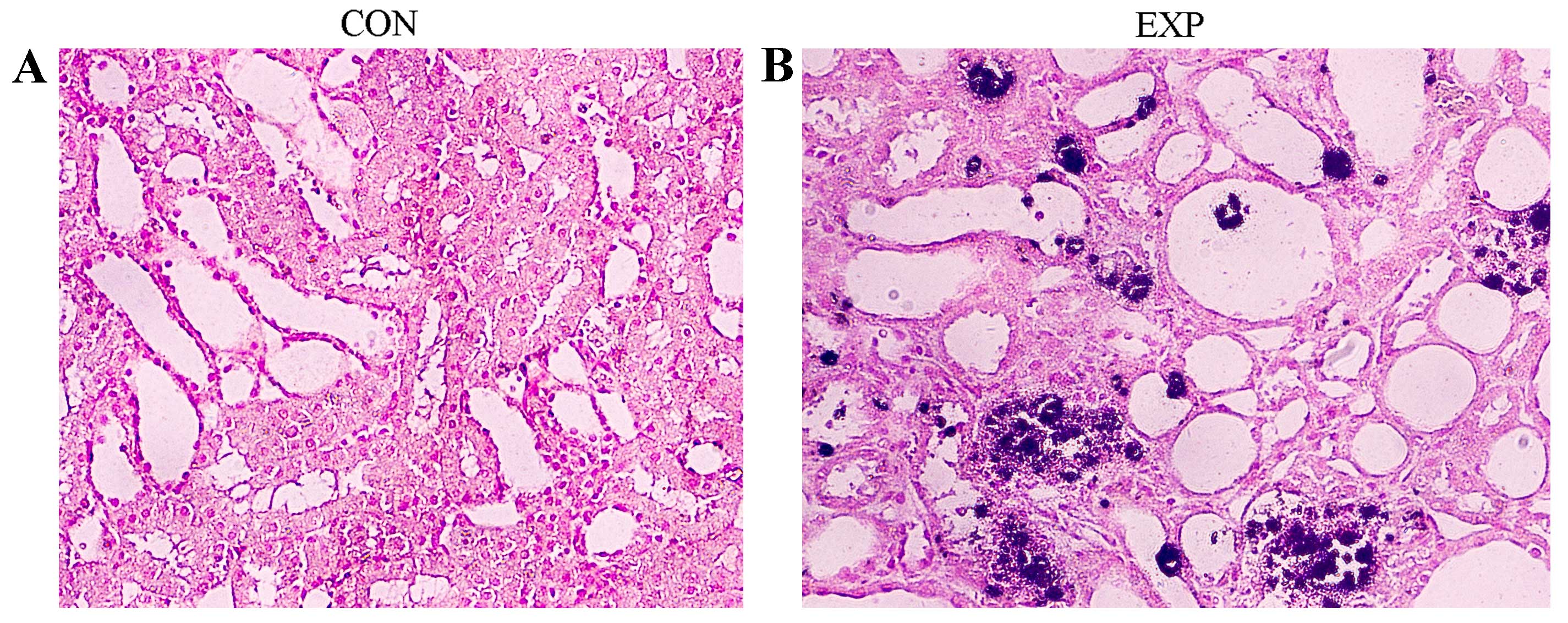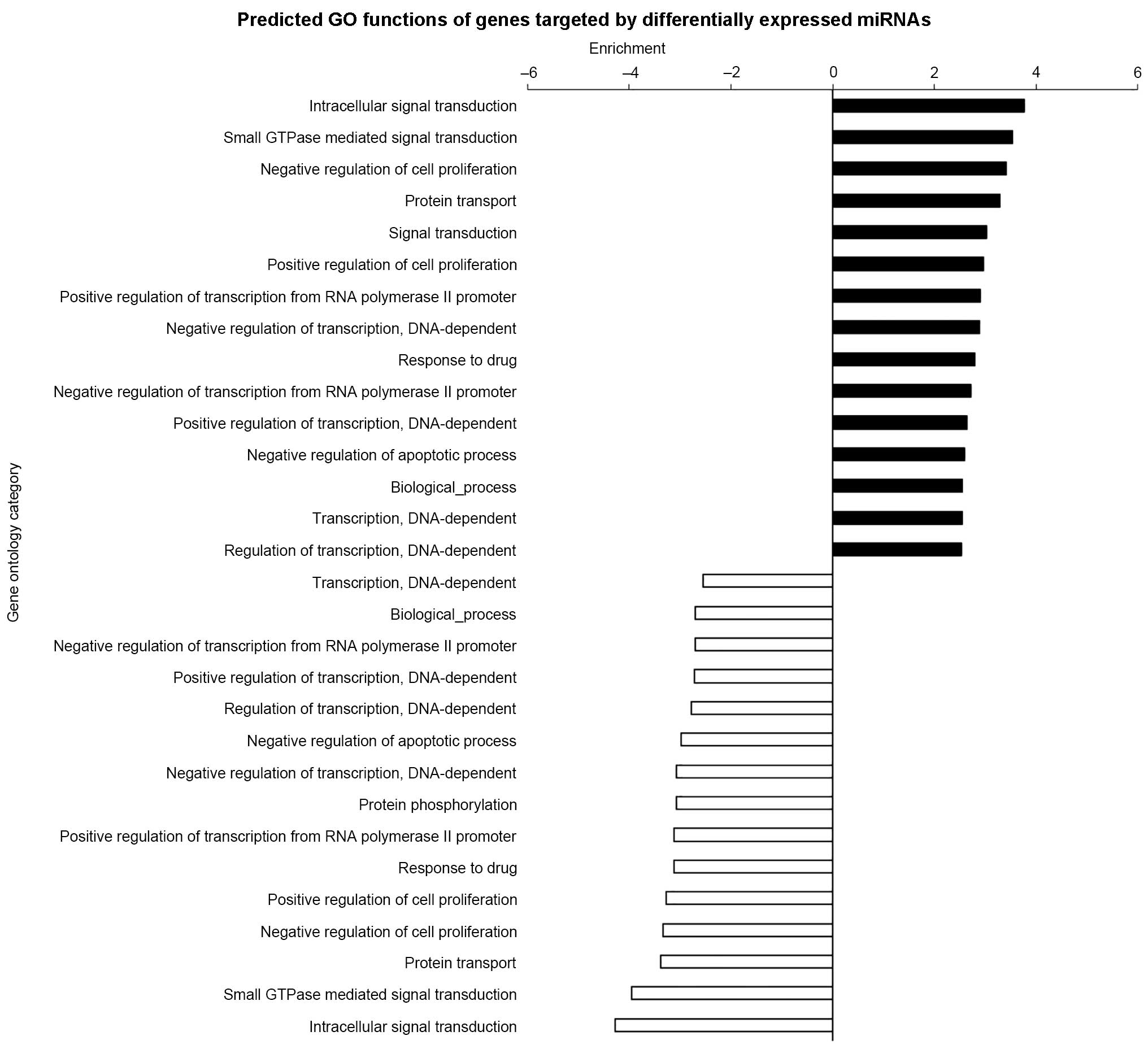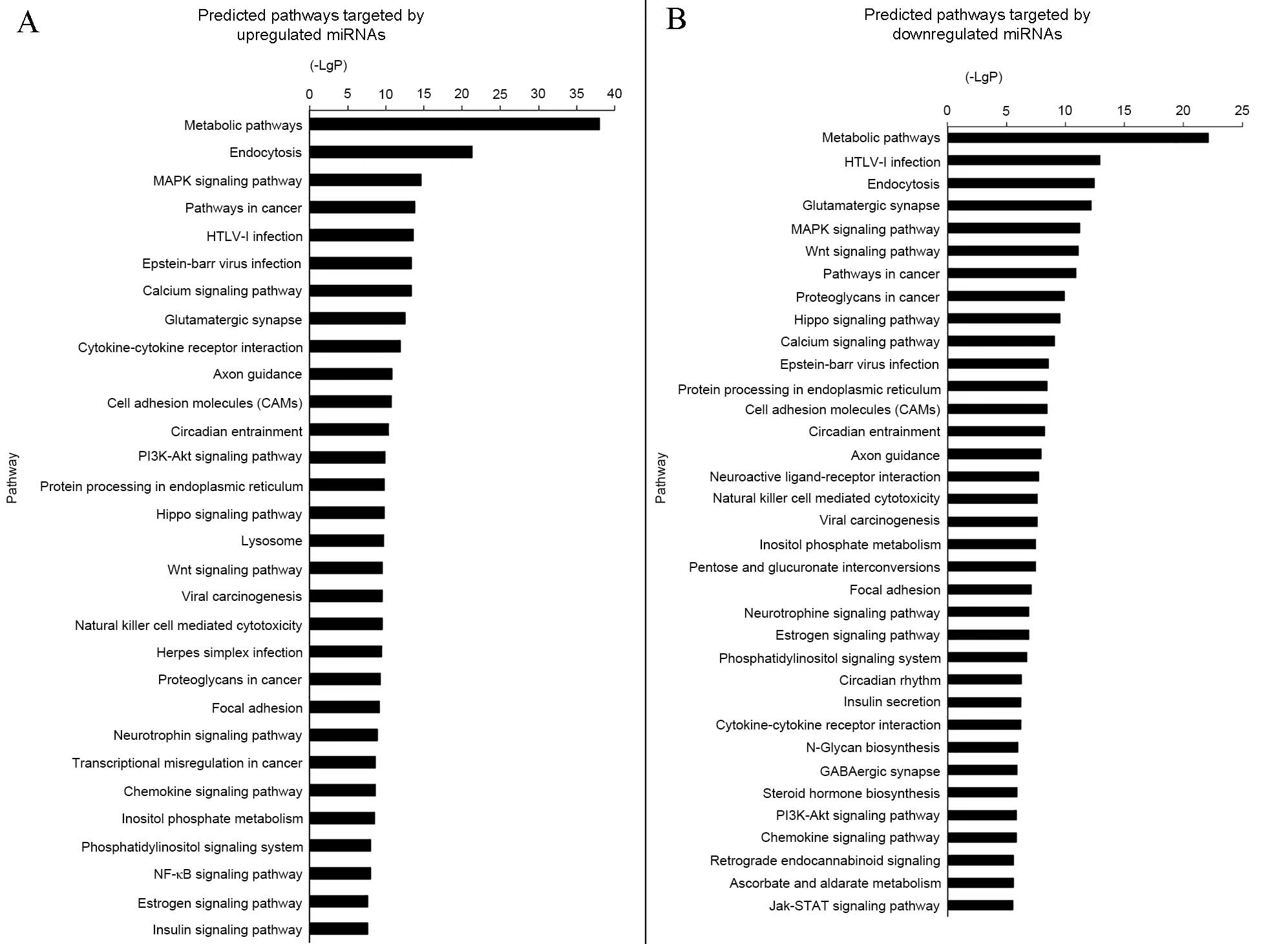|
1
|
Coe FL, Evan A and Worcester E: Kidney
stone disease. J Clin Invest. 115:2598–2608. 2005. View Article : Google Scholar : PubMed/NCBI
|
|
2
|
Ambros V: The functions of animal
microRNAs. Nature. 431:350–355. 2004. View Article : Google Scholar : PubMed/NCBI
|
|
3
|
Bartel DP: MicroRNAs: Genomics,
biogenesis, mechanism, and function. Cell. 116:281–297. 2004.
View Article : Google Scholar : PubMed/NCBI
|
|
4
|
Lewis BP, Burge CB and Bartel DP:
Conserved seed pairing, often flanked by adenosines, indicates that
thousands of human genes are microRNA targets. Cell. 120:15–20.
2005. View Article : Google Scholar : PubMed/NCBI
|
|
5
|
Lewis BP, Shih IH, Jones-Rhoades MW,
Bartel DP and Burge CB: Prediction of mammalian microRNA targets.
Cell. 115:787–798. 2003. View Article : Google Scholar : PubMed/NCBI
|
|
6
|
Xuehua C, Xiaojian G, Xizhao S, Li Z and
Yan X: The study of the determination of oxalate and citrate in
human urine by lon chromatography method. J Clin Urology (China).
28:437–439. 2013.
|
|
7
|
Institute of Laboratory Animal Resources
(US). Committee on Care, Use of Laboratory Animals, National
Institutes of Health (US), . Division of Research Resources. Guide
for the care and use of laboratory animals[M]. National Academies.
1985.
|
|
8
|
Wright GW and Simon RM: A random variance
model for detection of differential gene expression in small
microarray experiments. Bioinformatics. 19:2448–2455. 2003.
View Article : Google Scholar : PubMed/NCBI
|
|
9
|
Bolstad BM: Low-level analysis of
high-density oligonucleotide array data: Background, normalization
and summarization. University of California; Berkeley: 2004
|
|
10
|
Yang H, Crawford N, Lukes L, Finney R,
Lancaster M and Hunter KW: Metastasis predictive signature profiles
pre-exist in normal tissues. Clin Exp Metastasis. 22:593–603. 2005.
View Article : Google Scholar : PubMed/NCBI
|
|
11
|
Livak KJ and Schmittgen TD: Analysis of
relative gene expression data using real-time quantitative PCR and
the 2(−Delta Delta C(T)) method. Methods. 25:402–408. 2001.
View Article : Google Scholar : PubMed/NCBI
|
|
12
|
Gene Ontology Consortium, . The gene
ontology (GO) project in 2006. Nucleic Acids Res. 34:(Database
Issue). D322–D326. 2006. View Article : Google Scholar : PubMed/NCBI
|
|
13
|
Kanehisa M, Goto S, Kawashima S, Okuno Y
and Hattori M: The KEGG resource for deciphering the genome.
Nucleic Acids Res. 32:(Database Issue). D277–D280. 2004. View Article : Google Scholar : PubMed/NCBI
|
|
14
|
Yi M, Horton JD, Cohen JC, Hobbs HH and
Stephens RM: WholePathwayScope: A comprehensive pathway-based
analysis tool for high-throughput data. BMC Bioinformatics.
7:302006. View Article : Google Scholar : PubMed/NCBI
|
|
15
|
Enright AJ, John B, Gaul U, Tuschl T,
Sander C and Marks DS: MicroRNA targets in drosophila. Genome Biol.
5:R12003. View Article : Google Scholar : PubMed/NCBI
|
|
16
|
Joung JG, Hwang KB, Nam JW, Kim SJ and
Zhang BT: Discovery of microRNA-mRNA modules via population-based
probabilistic learning. Bioinformatics. 23:1141–1447. 2007.
View Article : Google Scholar : PubMed/NCBI
|
|
17
|
Shalgi R, Lieber D, Oren M and Pilpel Y:
Global and local architecture of the mammalian
microRNA-transcription factor regulatory network. PLoS Comput Biol.
3:e1312007. View Article : Google Scholar : PubMed/NCBI
|
|
18
|
Evan AP, Coe FL, Lingeman JE, Shao Y,
Matlaga BR, Kim SC, Bledsoe SB, Sommer AJ, Grynpas M, Philips CL
and Worcester EM: Renal crystal deposits and histopathology in
patients with cystine stones. Kidney Int. 69:2227–2235. 2006.
View Article : Google Scholar : PubMed/NCBI
|
|
19
|
Evan AP, Lingeman JE, Coe FL, Parks JH,
Bledsoe SB, Shao Y, Sommer AJ, Patterson RF, Kuo RL and Grynpas M:
Randall plaque of patients with nephrolithisis begins in basement
membranes of thin loops of Henle. J Clin Invest. 111:607–616. 2003.
View Article : Google Scholar : PubMed/NCBI
|
|
20
|
Verkoelen CF and Verhulst A: Proposed
mechanisms in renal tubular crystal retention. Kidney Int.
72:13–18. 2007. View Article : Google Scholar : PubMed/NCBI
|
|
21
|
Taylor ER and Stoller ML: Vascular theory
of the formation of Randall plaques. Urolithiasis. 43:(Suppl 1).
S41–S45. 2015. View Article : Google Scholar
|
|
22
|
de Bruijn WC, Boevé ER, van Run PR, van
Miert PP, de Water R, Romijn JC, Verkoelen CF, Cao LC and Schröder
FH: Etiology of calcium oxalate nephrolithiasis in rats. I. Can
this be a model for human stone formation? Scanning Microsc.
9:103–114. 1995.PubMed/NCBI
|
|
23
|
Cao Z and Liu J: Comparison of several
experimental renal calcium oxalate Calcalus ModelS in rats. J
Huazhong Univ Sci Tech. 31:556–559. 2002.
|
|
24
|
Wisener LV, Pearl DL, Houston DM,
Reid-Smith RJ and Moore AE: Risk factors for the incidence of
calcium oxalate uroliths or magnesium ammonium phosphate uroliths
for dogs in Ontario, Canada, from 1998 to 2006. Am J Vet Res.
71:1045–1054. 2010. View Article : Google Scholar : PubMed/NCBI
|
|
25
|
Halbritter J, Baum M, Hynes AM, Rice SJ,
Thwaites DT, Gucev ZS, Fisher B, Spaneas L, Porath JD, Braun DA, et
al: Fourteen monogenic genes account for 15% of
nephrolithiasis/nephrocalcinosis. J Am Soc Nephrol. 26:543–551.
2015. View Article : Google Scholar : PubMed/NCBI
|
|
26
|
Ouyang JM, Yao XQ, Tan J and Wang FX:
Renal epithelial cell injury and its promoting role in formation of
calcium oxalate monohydrate. J Biol Inorg Chem. 16:405–416. 2011.
View Article : Google Scholar : PubMed/NCBI
|
|
27
|
Sivalingam S, Nakada SY, Sehgal PD,
Crenshaw TD and Penniston KL: Dietary hydroxyproline induced
calcium oxalate lithiasis and associated renal injury in the
porcine model. J Endourol. 27:1493–1498. 2013. View Article : Google Scholar : PubMed/NCBI
|
|
28
|
Wang B, Wu B, Liu J, Yao W, Xia D, Li L,
Chen Z, Ye Z and Yu X: Analysis of altered microRNA expression
profiles in proximal renal tubular cells in response to calcium
oxalate monohydrate crystal adhesion: Implications for kidney stone
disease. PLoS One. 9:e1013062014. View Article : Google Scholar : PubMed/NCBI
|
|
29
|
Okumura N, Tsujihata M, Momohara C,
Yoshioka I, Suto K, Nonomura N, Okuyama A and Takao T: Diversity in
protein profiles of individual calcium oxalate kidney stones. PLoS
One. 8:e686242013. View Article : Google Scholar : PubMed/NCBI
|
|
30
|
Halbritter J, Baum M, Hynes AM, Rice SJ,
Thwaites DT, Gucev ZS, Fisher B, Spaneas L, Porath JD, Braun DA, et
al: Fourteen monogenic genes account for 15% of
nephrolithiasis/nephrocalcinosis. J Am Soc Nephrol. 26:543–551.
2015. View Article : Google Scholar : PubMed/NCBI
|
|
31
|
Jiang Z, Asplin JR, Evan AP, Rajendran VM,
Velazquez H, Nottoli TP, Binder HJ and Aronson PS: Calcium oxalate
urolithiasis in mice lacking anion transporter Slc26a6. Nat Genet.
38:474–478. 2006. View
Article : Google Scholar : PubMed/NCBI
|
|
32
|
Corbetta S, Eller-Vainicher C, Frigerio M,
Valaperta R, Costa E, Vicentini L, Baccarelli A, Beck-Peccoz P and
Spada A: Analysis of the 206M polymorphic variant of the SLC26A6
gene encoding a Cl-oxalate transporter in patients with primary
hyperparathyroidism. Eur J Endocrinol. 160:283–288. 2009.
View Article : Google Scholar : PubMed/NCBI
|
|
33
|
Alper SL and Sharma AK: The SLC26 gene
family of anion transporters and channels. Mol Aspects Med.
34:494–515. 2013. View Article : Google Scholar : PubMed/NCBI
|
|
34
|
Häcker H, Redecke V, Blagoev B,
Kratchmarova I, Hsu LC, Wang GG, Kamps MP, Raz E, Wagner H, Häcker
G, et al: Specificity in Toll-like receptor signalling through
distinct effector functions of TRAF3 and TRAF6. Nature.
439:204–207. 2006. View Article : Google Scholar : PubMed/NCBI
|
|
35
|
Oganesyan G, Saha SK, Guo B, He JQ,
Shahangian A, Zarnegar B, Perry A and Cheng G: Critical role of
TRAF3 in the Toll-like receptor-dependent and -independent
antiviral response. Nature. 439:208–211. 2006. View Article : Google Scholar : PubMed/NCBI
|
|
36
|
Mittal RD, Bid HK, Manchanda PK and Kapoor
R: Association of interleukin-1beta gene and receptor antagonist
polymorphisms with calcium oxalate urolithiasis. J Endourol.
21:1565–1570. 2007. View Article : Google Scholar : PubMed/NCBI
|
|
37
|
Reyes L, Reinhard M and Brown MB:
Different inflammatory responses are associated with Ureaplasma
parvum-induced UTI and urolith formation. BMC Infect Dis. 9:92009.
View Article : Google Scholar : PubMed/NCBI
|
|
38
|
Fujii Y, Okada A, Yasui T, Niimi K,
Hamamoto S, Hirose M, Kubota Y, Tozawa K, Hayashi Y and Kohri K:
Effect of adiponectin on kidney crystal formation in metabolic
syndrome model mice via inhibition of inflammation and apoptosis.
PLoS One. 8:e613432013. View Article : Google Scholar : PubMed/NCBI
|
|
39
|
Hu X, Wang M, Bei W, Han Z and Guo J: The
Chinese herbal medicine FTZ attenuates insulin resistance via IRS1
and PI3K in vitro and in rats with metabolic syndrome. J Transl
Med. 12:472014. View Article : Google Scholar : PubMed/NCBI
|
|
40
|
Kaur J: A comprehensive review on
metabolic syndrome. Cardiol Res Pract. 2014:9431622014.PubMed/NCBI
|
|
41
|
Sakhaee K, Capolongo G, Maalouf NM, Pasch
A, Moe OW, Poindexter J and Adams-Huet B: Metabolic syndrome and
the risk of calcium stones. Nephrol Dial Transplant. 27:3201–3209.
2012. View Article : Google Scholar : PubMed/NCBI
|
|
42
|
Kohjimoto Y, Sasaki Y, Iguchi M, Matsumura
N, Inagaki T and Hara I: Association of metabolic syndrome traits
and severity of kidney stones: Results from a nationwide survey on
urolithiasis in Japan. Am J Kidney Dis. 61:923–929. 2013.
View Article : Google Scholar : PubMed/NCBI
|
|
43
|
Kabeya Y, Kato K, Tomita M, Katsuki T,
Oikawa Y, Shimada A and Atsumi Y: Associations of insulin
resistance and glycemic control with the risk of kidney stones.
Intern Med. 51:699–705. 2012. View Article : Google Scholar : PubMed/NCBI
|
|
44
|
Khan SR: Is oxidative stress, a link
between nephrolithiasis and obesity, hypertension, diabetes,
chronic kidney disease, metabolic syndrome? Urol Res. 40:95–112.
2012. View Article : Google Scholar : PubMed/NCBI
|














